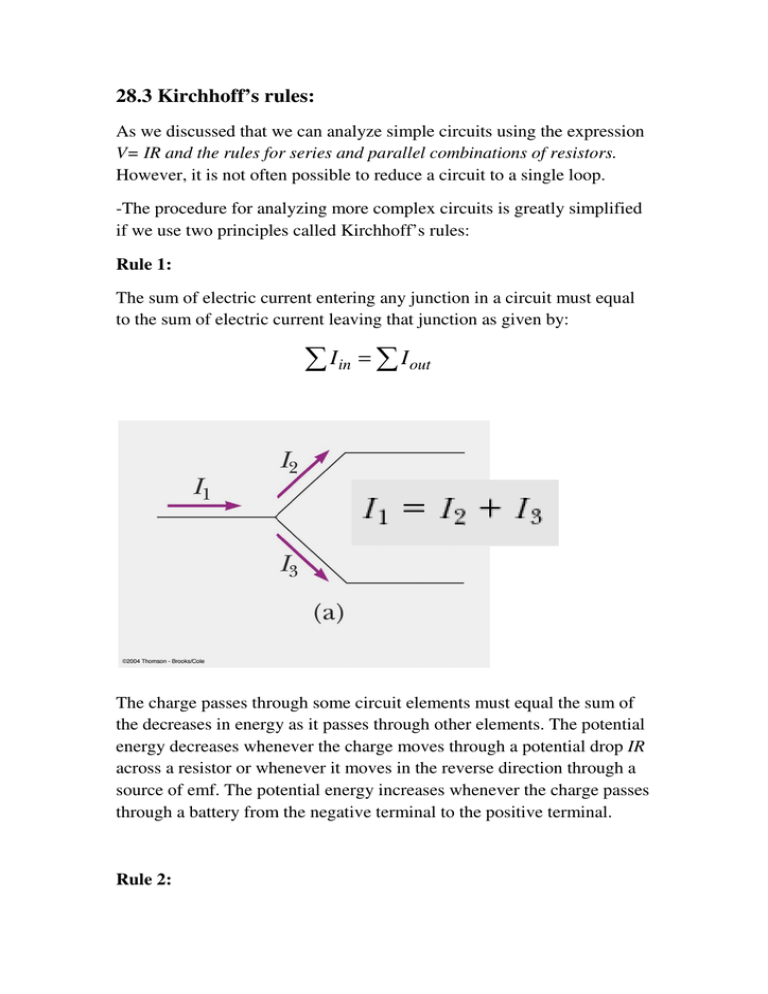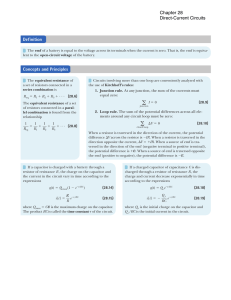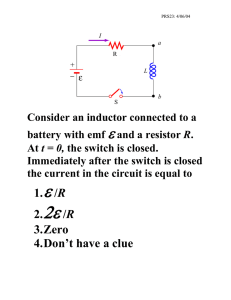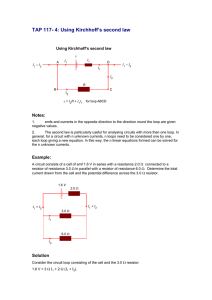Lecture 17
advertisement

28.3 Kirchhoff’s rules: rules As we discussed that we can analyze simple circuits using the expression V= IR and the rules for series and parallel combinations of resistors. However, it is not often possible to reduce a circuit to a single loop. -The procedure for analyzing more complex circuits is greatly simplified if we use two principles called Kirchhoff’s rules: Rule 1: The sum of electric current entering any junction in a circuit must equal to the sum of electric current leaving that junction as given by: by ∑ Iin = ∑ I out The charge passes through some circuit elements must equal the sum of the decreases in energy as it passes through other elements. The potential energy decreases whenever the charge moves through a potential drop IR across a resistor or whenever it moves in in the reverse direction through a source of emf. The potential energy increases whenever the charge passes through a battery from the negative terminal to the positive terminal. Rule 2: The sum of the potential difference across all electric elements around any closed circuit loop must equal zero, zero ∑ ∇V = 0 Let us imagine moving a charge around the loop. When the charge returns to the starting point, the charge––circuit system must have the same energy as when the charge started from it. The sum of the increases in energy in some circuit elements must equal the sum of the decreases in energy in other elements. The potential energy decreases whenever the charge moves through a potential drop IR across cross a resistor or whenever it moves in the reverse direction through a source of emf. The potential energy increases when-ever when ever the charge passes through a battery from the negative terminal to the positive terminal. Each circuit element is traversed from f left to right • Because charges move from the highhigh potential end of a resistor to the low potential end, if a resistor is traversed in the direction of the current, the change in potential V across the resistor is - IR • If a resistor is traversed in the direction opposite the current, the change in potential V across the resistor is + IR • If a source of emf (assumed to have zero internal resistance) is traversed in the direction of the emf (from - to+ ), the change ch in potential V is +ε. The emf of the battery increases the electric potential as we move through it in this direction. • If a source of emf (assumed to have zero internal resistance) is traversed in the direction opposite the emf (from + to - ), the change in potential V is - ε. In this case the emf of the battery reduces the electric potential as we move through it. You may follow the following steps when wanting to solve problems based on Kirchhoff’s rules: 1) Identify all of the junctions or branch points in the circuit. 2) Identify the current loops that exist in the circuit. Choose any loop and apply the loop rule. Remember that (+) to (-) is a potential drop while (-) to (+) is a potential gain. Write equations for each loop. Remember that the sums of the potential drops and gains must be zero. 3) Reapply the loop rule as needed. For each unknown current you will need to write an equation. The fewer terms in which you express unknown currents, the fewer equations you have to write. 4) Solve the equations to determine the unknown currents. Examples 28.7 and 28.8 Example: Find the electric current passing through R = 10 Ω? 1Ω 6Ω 3Ω 10 Ω 20 V 5Ω I= 1 A Example: Find the electric current passing through the resistor of 3 Ω. 15 V 3Ω 4Ω 5Ω 6Ω 5V 2Ω I=0.5A Example: Find the current I2 in the following circuit. Ω Ω Ω Ω Ω Ω RC CIRCUITE: Example: Please note that at steady state condition: I=0 in the abgha closed loop







